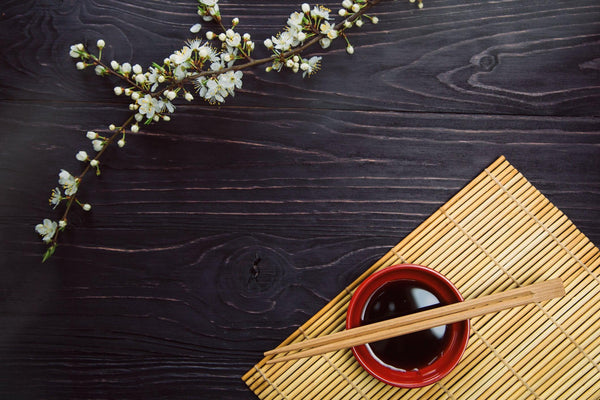
Jump to:
Shoyu, the Japanese word for soy sauce, is one of the most important seasonings in Japanese cuisine. Known for its salty, savory, and umami-rich flavor, shoyu can be used in countless ways, from enhancing soups and stews to serving as a dipping sauce for sushi, tofu, or grilled meat. But what is shoyu soy sauce exactly, and is shoyu the same as soy sauce?
In this guide, we’ll explain everything you need to know about shoyu sauce: its history, how it’s made, the different types of Japanese soy sauce, popular brands, and why it’s such an integral part of Japanese cooking.
What Is Shoyu?

Shoyu is one of the most important seasonings in Japanese cuisine. It refers to Japanese soy sauce made from soybeans, wheat, salt, and water. Depending on the type of soy sauce and the maker, the ratio and ingredients can change. Japanese shoyu is typically light brown in color and has a thin texture.
Shoyu is also one of the main seasonings used in Japanese cuisine and is used not only to add additional salty flavor but also umami, which is often described as the 5th sense of taste. You can find shoyu commonly served as a dipping sauce for sushi, grilled meat, tofu, and vegetables. It can also be used to add flavor to soups, stews, and marinades.
Is Shoyu The Same As Soy Sauce?
It may be a bit tricky to understand what shoyu is compared to soy sauce if you find them side to side at the grocery store. Generally speaking, shoyu is the Japanese word for soy sauce, meaning that shoyu only refers to authentic Japanese soy sauces.
People often describe the umami shoyu taste as balanced, savory, and complex. Some brands even highlight it as umami shoyu sauce to emphasize this rich flavor.
Here’s a quick comparison guide to help you understand the difference between shoyu soy sauce vs regular soy sauce:
Shoyu Soy Sauce Vs Soy Sauce
|
Feature |
Shoyu (Japanese Soy Sauce) |
Regular Soy Sauce (General/Other Countries) |
|---|---|---|
|
Origin |
Japan |
China and other Asian countries |
|
Ingredients |
Typically soybeans, wheat, salt, and water |
Varies, may use more soy, less wheat, or other grains |
|
Brewing Method |
Traditionally brewed (honjozo method, natural fermentation) |
May use chemical hydrolysis or shorter fermentation |
|
Taste/ Flavor Profile |
Balanced salty and umami-rich taste, lighter and smoother |
Can be saltier, sharper, or more intense depending on style |
|
Color |
Light to medium brown |
Often darker or thicker |
|
Common Uses |
Sushi, sashimi, grilled fish, tofu, soups, dipping sauces |
Stir-fries, marinades, braised dishes, general seasoning |
|
Varieties |
Shiro, Usukuchi, Koikuchi, Tamari, Saishikomi, Amakuchi |
Light, dark, mushroom, sweet soy, etc. |
Where Does Shoyu Come From?

Shoyu has a long history that dates back hundreds of years, from its origins as an ancient Chinese preserve known as jiang, to its modern-day use as one of Asia’s staple cooking ingredients and marinades, used widely across much of the world.
According to the Japanese official Soy Sauce Information Center, Japanese shoyu originated in the Kansai region around 1580. During this time, a company known as Tamai Soy Sauce began selling shoyu and miso paste to the people of Osaka, becoming what is thought to be the first shoyu vendor in Japan. Eventually, shoyu began to be shipped from the Kansai region to Kanto and other areas of Japan.
By the time Japan’s Edo period began in 1603, the cities of Noda and Chosi in Chiba prefecture had also become major shoyu-producing regions, creating a product more similar in taste to the shoyu that we buy today.
How Is Shoyu Made?

Traditional brewing methods define classic shoyu sauce. If you’ve ever wondered what is shoyu made of or what the typical shoyu sauce ingredients are, the answer is simple: soybeans, wheat, salt, and water.
The all-purpose shoyu that is commonly found in supermarkets is a thin, brown liquid made by using a fermenting method known as honjozo in Japanese. In this process, soybeans and wheat are mixed together before mold spores known as koji are added to begin the fermentation process.
This koji mixture is then left in a tank for at least six months before it turns into a material known as moromi, which is also used in the sake brewing process in addition to shoyu. Finally at the end of the brewing process through further fermentation and maturation, the moromi is filtered, blended, and aged to achieve well-balanced flavor and becomes shoyu.
Different Types Of Shoyu
There are many different types of shoyu that exist in Japan, depending on a multitude of factors such as the region, ingredients available, brewing methods, and more. However, generally speaking, there are six main types of shoyu that you should know about.
Shiro Shoyu

Starting with the lightest of all the shoyu, Shiro Shoyu, which translates to white soy sauce is used mainly as a flavoring agent for soups. Shiro shoyu, a shoyu that originally comes from Aichi prefecture, is pale, or almost translucent in color, making it the ideal shoyu to use in dishes where preserving the color of the dish is important.
Shiro shoyu is also a popular choice for salad dressings, as the flavor is salty but not too overpowering. One way to use shiro shoyu is by mixing it with olive oil to make a simple and yummy salad dressing.
Usukuchi Shoyu

Usukuchi Shoyu, or light soy sauce, is another light-colored shoyu that originated in the Kansai region of Japan. Though its name means light or pale color, this type of shoyu is definitely not lacking in flavor! Usukuchi shoyu actually contains more salt than most other kinds of shoyu.
Since usukuchi shoyu is very salty, it should be used in small amounts and may not be suitable as a dipping shoyu. Usukuchi shoyu is a good shoyu to use when you want to add salty and umami flavor to a dish, without altering its color too much.
Amakuchi Shoyu

Amakuchi Shoyu is a type of sweet shoyu that comes from the Kyushu region and is the most popular type of shoyu in that region thanks to its deep ties to the local area. Whilst there is some debate about why this sweet shoyu is so popular in Kyushu, it is often said that it could be related to the fact that a large amount of sugar used to be imported to Japan from the Netherlands through Nagasaki Port.
While amakuchi shoyu is a suitable shoyu to use as a marinade or seasoning in dishes where a sweet and salty flavor is desirable, it also works great as a basting for yaki-onigiri or as a seasoning for tamagoyaki.
Koikuchi Shoyu

Koikuchi shoyu, which roughly translates to “dark mouth” soy sauce accounts for around 80% of the shoyu produced in Japan. Koikuchi shoyu is the most common and widely used Japanese shoyu. If you’re new to the world of shoyu, we recommend starting with a Koikuchi shoyu.
Made from equal parts of soy and wheat, koikuchi shoyu provides dishes with a well-balanced salty and umami flavor and is very versatile. In fact, koikuchi shoyu can be used in cooking and for dipping, but pairs especially well with grilled fish dishes.
Saishikomi Shoyu

Saishikomi Shoyu is a type of shoyu that is brewed twice, giving it a unique and intense umami flavor that is not found in other types of shoyu. It is darker in color than koikuchi shoyu because the excess water and brine are removed from it during its second fermentation. Saishikomi shoyu is thick and has somewhat of a sweet flavor.
Since so much time and care goes into making this particular shoyu, it is not recommended to use it for everyday cooking. Instead, enjoy its rich flavor as a dipping sauce for steak or even sushi.
Tamari Shoyu

Tamari vs shoyu are both types of Japanese soy sauce, but they differ in ingredients and flavor. Shoyu, made from soybeans and wheat, has a balanced, lighter umami taste perfect for everyday cooking like soups, stir-fries, and dipping sauces.
Tamari shoyu, the sixth main type of shoyu produced mainly in the Chubu region of Central Japan, is thicker, denser, and less salty, often served with sashimi or used in teriyaki. Its mild sweetness and rich texture make it ideal for gluten-free cooking, as it usually contains little to no wheat, though some brands may have trace amounts, so checking the label is recommended.
Choosing A Good Shoyu
When choosing a quality Japanese shoyu, there are a few pieces of information to keep in mind. First, the most important thing is to look at the ingredients list. Remember that shoyu is generally made of only soybeans, wheat, salt, and water. Bottles of shoyu that contain other ingredients such as chemicals and preservatives to extend the shelf life or “add flavor” are clear signs that the shoyu is not very high quality.
Another important factor to consider is where the ingredients come from. These days, it is common to find shoyu using soybeans produced outside of Japan. This will not make or break if the shoyu is quality tasting or not, but genetic modification is a common practice for soybeans, and some people may be wary about it.
While Yamaroku’s Tsurubishio is one of the most famous barrel-aged shoyu, there are actually other premium options worth exploring. We’ve put together a guide on the 6 Best Japanese Soy Sauces, highlighting exceptional bottles that go beyond even this well-known brand.
Which Shoyu Is The Best?

Depending on the dish that you are preparing, different kinds of shoyu bring out different flavors. The five elements that contribute to the taste of shoyu include saltiness, sweetness, acidity, bitterness, and umami.
A Japanese light soy sauce such as shiro shoyu is better for use in light soups whilst usukuchi shoyu is commonly used in broths for noodle soup or other simmered dishes because it is lighter in color. As mentioned previously, tamari is excellent when served with sushi and sashimi due to its lower salt content and is also used in the production of senbei rice crackers.
For fans of Japanese cuisine, you may have noticed that shoyu is also used when creating pickled dishes, known as shoyuzuke in Japanese. Regular shoyu can be used for creating soy sauce pickles and popular side dishes include Japanese pickled cucumbers or daikon radish.
There are also a number of shoyu condiments designed to be paired with specific dishes, from a Japanese salad dressing shoyu, to tare sauces where sugar and spices are added to shoyu to create a marinade for skewered meats known as yakitori in Japanese. Ponzu soy sauce is also a popular citrus-flavored dipping sauce that is used for grilled meats or with cold noodles.
Japanese seasoning company Yamagen Jouzu has also created a ‘wasabi shoyu’, a soy sauce with wasabi flavor, ideal for serving with beef dishes.
Japanese Shoyu Brands

Top brands like Kikkoman, Takesan, Teraoka, and Adachi Jozo produce sauce shoyu that’s enjoyed globally.
One of the most well-known shoyu brands not only in Japan but around the world is Kikkoman, whose roots date back to the mid-17th century. Originally known as the Noda Shoyu Co. Ltd, Kikkoman eventually changed its name to Kikkoman in 1964. After the Second World War, Kikkoman began to significantly increase their overseas exports and today they have three production plants in Japan and seven overseas.
Kikkoman considers its light soy sauce to be unique compared to other companies because it still uses the traditional honjozo brewing process during its production, and its sauce does not include any artificial flavors or preservatives. This results in a different taste compared to other brewing methods and companies who include additives like MSG to manipulate the final taste. The caramel reddish-brown color of Kikkoman shoyu is also different to the much darker sauces produced by companies who use additives.
Yamasa, which was founded in 1645 by Gihei Hamaguchi in Chosi, located in Chiba prefecture. Like Kikkoman, Yamasa combines modern technology with traditional brewing methods to create a high-quality shoyu used by many of Japan’s top professional chefs. Yamasa’s products range from their regular shoyu for everyday cooking to specialist shoyu to be served with sashimi and sushi, in addition to thicker teriyaki sauces.
If you’re looking for a more premium shoyu brand, Takesan Kishibori Shoyu is a gourmet product with a rich flavor, deep color, and intense aroma. The Takesan company was established on the Mediterranean-like island of Shodoshima located in the Japanese Inland Sea, famous for its stunning nature and olive oil production in addition to shoyu. Takesan Kishibori Shoyu is brewed using the whole soybean, wheat, and natural salt before being placed in barrels made from ancient kioke (cedar wood) for one year to ferment.
Another premium shoyu brand is Teraoka, based in Hiroshima. Teraoka’s premium barrel-aged shoyu is perfect for those who are looking to try a higher-quality shoyu. Their flagship barrel-aged shoyu is naturally fermented in kioke cedar barrels before being packaged and sold to consumers. This time-intensive process brings out unique characteristics like more glutamic acid and umami compounds, that cannot be found in other kinds of shoyu. Best of all, this shoyu can be used as a dipping sauce, as well as included in marinades and seasonings. Learn more about Teraoka in this blog post.
Adachi Jozo is another artisanal shoyu brand that not only relies on traditional brewing methods to produce its shoyu but is also extremely particular about the quality of raw materials they use to make shoyu. Produced in a small town called Taka located in the center of Hyogo Prefecture, Adachi has continued to rely on traditional shoyu brewing methods, by aging their shoyu in wooden barrels for a minimum of one year to give it a unique and distinctive umami flavor.
Can You Substitute Soy Sauce For Shoyu?
While you technically can substitute other kinds of soy sauce, like Chinese soy sauce for shoyu in recipes, it is not recommended to do this. Of course if you do not cook Japanese cuisine often and do not want to go through the trouble of purchasing another bottle of soy sauce, it is okay to use Chinese soy sauce in a pinch, but it will alter the flavor of the dish.
If you are interested in Japanese cuisine and want to cook or eat it often at home, purchasing a high-quality and authentic Japanese shoyu will make all the difference!
How To Store Shoyu

To ensure that your shoyu retains its flavor, before opening, it’s best to keep it in a cool, dry storage cupboard or pantry.
Shoyu doesn’t need to be refrigerated and will keep at room temperature, however, once the bottle has been opened it will retain its flavor for longer if you do refrigerate it. According to Kikkoman, keeping the shoyu at a higher temperature will increase the sauce’s contact with oxygen, turning the sauce darker in color and lessening its flavor.
Most shoyu will come with an expiration date on the label and will keep up to two years after opening if kept in the correct storage conditions. However, an unopened bottle of shoyu won’t really go bad and can be kept indefinitely if stored in a pantry.
Find the Perfect Shoyu for Every Dish
Shoyu is more than just soy sauce, it’s a cornerstone of Japanese cuisine, crafted with centuries of tradition. From delicate shiro shoyu to bold tamari, each variety brings its own unique flavor.
Check out our shoyu soy sauce products and bring authentic Japanese taste to your kitchen! For someone new, I’d recommend starting with koikuchi shoyu as your everyday soy sauce, then trying shiro or usukuchi for lighter dishes. Once you’re comfortable, you can branch into tamari and saishikomi for richer, gourmet experiences.


0 comments